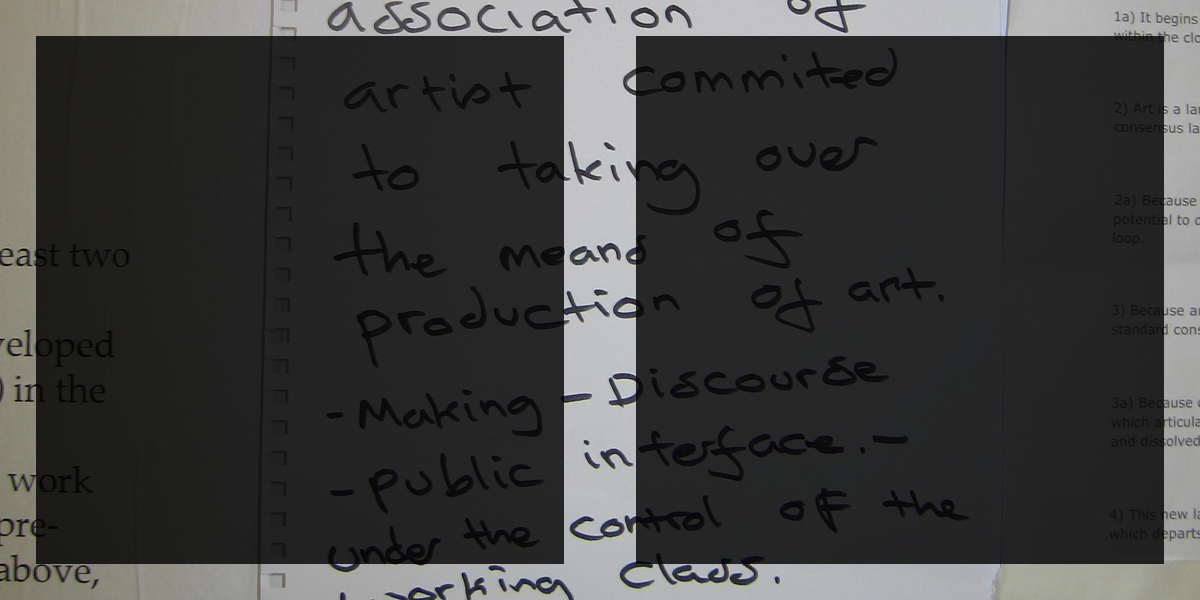
Sunday 6th October 4 - 6pm
How can we shape a culture as a collective act, creating interfaces between whom and what art acts upon, a new necessary art of sustained resistance?
What constitutes resistance in the face of class struggle?
In ancient Celtic history domination meant loosing your tongue. [1] We will not be concerned with taste here but speech and how art becomes an organ of speech. Art can open out hidden relationships between people, things and the world we inhabit; how then does art realise its potential to question and open out hidden relations including the social relations of art itself?
In developed capitalist countries the freedom of art appears like a totem for the social freedom of criticality, but to what ends? Acknowledging the reality of class antagonism in its fullest sense, who does this ‘image of freedom’ serve? [2] Exclusion often accompanies serious critique and this negates the aim of changing the social and economic relations that determine distribution of resources and ownership of property necessary for public interaction with art. This is the wall of class antagonism that we must come up against. Far too often, in the demarcation of an autonomous 'safe' space we have the fiction that art is independent rather than interdependent. Real autonomy is a position in relation to other social relations that we are able to investigate unimpeded; it is neutralized when fetishised as an unquestioned ‘image of freedom’ within narrow unacknowledged constraints. Social conditions affect how many people have access to and how easy it is to gain time and resources to practice art. In many capitalist countries we are living at a cross roads: many of the daughters and sons of the proletariat [3] have taken the opportunity of hard-won post-war, progressive education policies to study art practice. Despite issues of interpellation into notions of capitalist meritocracies we should acknowledge that new resistance and questioning of exploitation has emerged, the student protests and teach-ins in 2010 are one example. [4] The tide of these reforms has been on the ebb for several decades. After 2008 we are at a point in history when rights for future generations are being removed as access to tertiary education becomes increasingly limited, with high tuition fees and the increasing prevalence of business ideology.
Unmasking the often unseen conglomerate of forces of phenomena can potentially lead to revolutionary change [5]. What if we were to truly acknowledge the interdependence of all productions of social relations and culture? Included in this would be deracinating images and metaphors which art is heir to, opening up new potentials; Marx himself uses imagery as powerful tools of communication [6], delving into the symbolic structure of what appears as ‘common sense’ –the powers of the imagination should not be relinquished to capitalism. Artists must be producers [7], shaping a culture, creating interfaces between whom and what art acts upon. How can we shape a culture as a collective act, creating soil for a new necessary art of sustained resistance and struggle?
- See Tony Harrison’s poem ‘National Trust’ (www.poetryarchive.org) ‘Mes den hep tavas a-gollas y dyr (Cornish-)
'the tongueless man gets his land took.'
I first came across this image of removal of tongues in a copy of a Victorian book I no longer possess on Irish Celtic Mythology which stated that conquered tribes had their tongues removed.
- See Alain Badiou ‘Philosophy and Desire’, (Infinite Thought) where he talks about the limitations placed on philosophy, and the importance of revolt, risk, universality and logic
- I’d like to compare this with the condition of the proletariat described by Trotsky in ‘The Communist Policy Toward Art‘
- "There was a free teach-in at 5 o'clock and various speakers came and talked about the consequences of the cuts on the arts and education. "When we tried to leave, we couldn't as there was a confusion over which exit to use. Some students wanted to get into the Turner prize gallery itself and they began to chant, 'break down the doors, free education for all'. A lecturer at the Tate Gallery Occupation 2010 (http://www.guardian.co.uk/education/2010/dec/06/student-protests-turner-prize)
- Much of the thinking here has been shaped by considering Delueze's Difference and Repetition, in particular Chap 3 ‘The Image of Thought’. Also Brian Massumi, -A User's Guide to Capitalism and Schizophrenia:Deviations from Deleuze and Guattari
- Marx lays bare the relations that create commodity fetishism, but he warns that we may think a commodity is a simple thing, but is in fact not so easy to understand. He describes a table which takes on a life of its own and dances as a commodity. This is a famous example but there are many other images of allegory, metaphor in volume one of Capital. Chap 1 Section 4 P163
- See the ‘Author as Producer Walter’ by Walter Benjamin’ (http://communistgallery.wordpress.com/development-2/walter-benjamin-author-as-producer/ )
